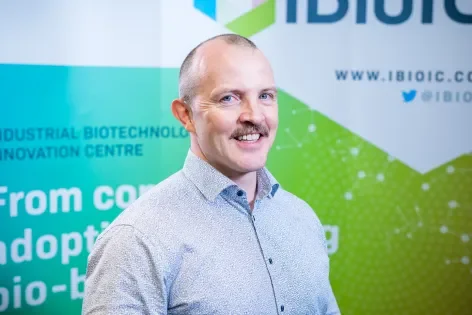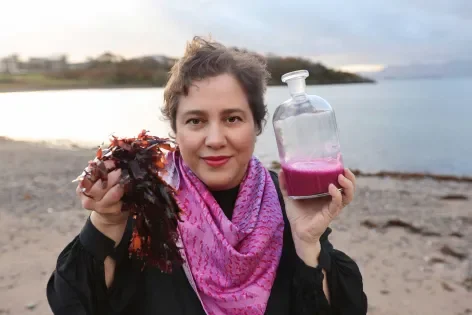How biotechnology is stitching sustainability into the fashion industry
Kim Cameron, Senior Impact Manager at the Industrial Biotechnology Innovation Centre (IBioIC), explains how biotechnology is stitching sustainability into the fashion industry.
From the cotton fields and oil wells that provide today’s fibres to the landfill sites where old garments end up, fashion’s environmental impact is felt across its full value chain.
With around 92 million tonnes of textile waste generated globally each year, the industry is under increasing pressure to put sustainability at its core. Rising consumption, complex global supply chains, and a continued dependence on fossil fuel-derived materials make the scale and speed of change required challenging.
One of the most promising routes forward lies in biotechnology. By harnessing living systems such as plants, enzymes, and microbes, innovators are developing eco-friendly, bio-based alternatives to conventional fibres, dyes, and production methods.
These innovations can match, and in some cases surpass, the performance of traditional materials while reducing their environmental impact. Across the UK, collaborations between scientists, manufacturers and brands are showing how fashion and biotechnology can come together to reimagine the industry.
Redesigning the fabrics we know
Many of fashion’s staple textiles are either resource-intensive to produce or derived from fossil fuels. Elastane, for instance, is valued for its stretch and recovery in activewear, underwear, and denim, but is typically petrochemical-based.
Alternatives are emerging, with London-based Tera Mira creating a compostable alternative using seaweed, offering the same flexibility and durability without reliance on non-renewable sources.
Other advances are pushing beyond conventional textiles entirely. Companies such as Bolt Threads and MycoWorks are cultivating mycelium – the root system of mushrooms – into a leather-like material that’s biodegradable yet durable enough for shoes, bags, and accessories.
Crucially, many of these next-generation fabrics are designed as ‘drop-in’ replacements, meaning manufacturers can integrate them into existing production lines without costly retooling. This approach helps overcome one of the key challenges in scaling up sustainable materials, making it easier for them to be adopted at scale.
Rethinking colour and finishing
SeaDyes extracts pigments from seaweed to produce natural, vibrant colours. Image credit: Kevin McGlynn.
SeaDyes extracts pigments from seaweed to produce natural, vibrant colours. Image credit: Kevin McGlynn.
Dyeing, printing and finishing are some of the most resource-intensive stages in the fashion supply chain, consuming vast amounts of water and chemicals.
In 2024, these processes accounted for an estimated 3% of global carbon dioxide emissions – a figure that could rise to 10% by 2050 if practices don’t change.
Biotechnology is offering a cleaner path. Pigments grown from plant or marine-based ingredients reduce dependence on petrochemical-based dyes and the pollution they cause.
In Dundee, start-up SeaDyes extracts pigments from seaweed to produce natural, vibrant colours, while Brilliant Dyes, a spinout from Imperial College London, is developing a microalgae-based dye system.
These bio-based solutions don’t just improve environmental performance – they can also bond more efficiently to fibres, cutting down on auxiliary chemicals and energy-intensive heat treatments.
Blending tradition with innovation
Prickly Thistle has explored the use of enzymes to naturally break down coarse Scottish wool fibres.
In other examples, Scotland’s rich textile heritage has offered a unique opportunity to bring together tradition and technology.
In collaboration with the University of Edinburgh and Johnstons of Elgin, Highlands-based Prickly Thistle has explored the use of enzymes to naturally break down coarse Scottish wool fibres, creating softer, more versatile fabrics that can compete with products imported from overseas.
Scaling up this approach to textiles production could support local economies and reduce reliance on global supply chains while also celebrating regional identity.
Reinventing fibre production is only part of the challenge – scaling fibre-to-fibre recycling is equally critical. Currently, less than 1% of discarded clothing is recycled into new garments.
Enzyme-based recycling could unlock this by breaking down blended fabrics, such as polyester–cotton, into their original components for re-spinning and re-weaving into new textiles.
Biotechnology is also being applied to wastewater treatment, with microbial systems capable of capturing residual dyes and purifying process water for reuse in mills.
These advances can reduce chemical pollutants while helping manufacturers hit environmental compliance targets.
Designing a circular future
By harnessing local feedstocks – from agricultural by-products to forestry residues and seaweed – biotechnology can help replace chemical-intensive processes, reduce emissions, and build greater resilience into fashion’s supply chains.
The challenge now is scaling. Much textile manufacturing still happens overseas, so translating lab and pilot-scale breakthroughs into production at scale is critical. Consumer behaviour will also need to shift, but leadership from major brands is vital.
Programmes like the H&M Foundation Global Change Award highlight how big players can champion new technologies, while partnerships such as IBioIC’s collaboration with the UK Fashion & Textile Association (UKFT) are exploring biotech’s role in tackling some of the sector’s toughest problems.
While biotechnology won’t solve every challenge, the momentum is clear. From bio-based leathers and compostable stretch fibres to natural dyes and fibre-to-fibre recycling, success stories are already emerging.
By bringing together science, design, and manufacturing expertise, fashion can move towards a circular model where style and sustainability truly go hand in hand.


